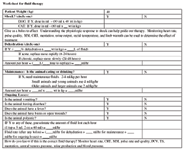Recognizing shock (Proceedings)
Shock is the general term used to describe several conditions that lead to inadequate perfusion of the tissues. There are multiple types of shock, but the common derangement in all forms is inadequate delivery of oxygen and nutrients to the cells and inadequate elimination of metabolic byproducts.
Definition of shock
Shock is the general term used to describe several conditions that lead to inadequate perfusion of the tissues. There are multiple types of shock, but the common derangement in all forms is inadequate delivery of oxygen and nutrients to the cells and inadequate elimination of metabolic byproducts.
Types of Shock
• Cardiogenic shock results from an inability of the heart to propel the blood through the circulation. Cardiogenic shock can result from anything that interferes with the ability of the heart to fill or pump blood. Examples of this type of shock are heart failure, arrhythmias, pericardial effusion, or tension pneumothorax.
• Hypovilemic shock results from inadequate circulating blood volume. Causes of hypovolemia include blood loss, water loss (severe dehydration) and third spacing of body fluids.
• Distributive shock results from massive vasodilation. The consequence of this vasodilation is that the amount of blood in circulation is inadequate to fill the vascular space, creating an effective hypovolemia. The most common type of distributive shock is septic shock. Because patients with "septic shock" do not always have a source of infection, a more recent term to describe the condition seen in septic shock is the systemic inflammatory response syndrome (SIRS). In septic shock, the immune system is activated and inflammatory mediators are produced that cause vasodilation. In addition to vasodilation, these inflammatory mediators lead to stimulation of coagulation, fever, release of more mediators, tissue injury and increased vascular permeability. Septic shock can also progress to hypovolemic and cardiogenic forms of shock. Distributive shock can also result from neurogenic, anaphylactic, or drug induced systemic vasodilation.
• Hypoxic shock results from tissue hypoxia from other causes such as pulmonary disease, anemia or toxins that interfere with oxygen delivery or metabolism.
Case example
You are presented with a 10 year old female, spayed, 40 kg Boxer with a 4-day history of vomiting. She had a mast cell tumor removed 4 days ago and was treated with an anti-emetic, an antihistamine and steroids for 2 days.
Physical exam findings
- Temperature: 103.1°F (normal 100.5-102.5)
- Pulse rate: 160 bpm (normal for a large dog 60-120)
- Pulse quality: snappy
- Mucous membranes: pale pink
- Capillary refill time: 2.5 sec
- Respiratory rate: 60 bpm (normal 20-30), inspiratory dyspnea, dull lung sounds
- No heart murmur
- Hydration: 7% dehydrated
- Mentation: depressed
- Abdomen: distended

Table 1
Database results
PCV 50%, TS 5.6 g/dl, icteric serum
• Interpretation
- Mild hemoconcentration due to dehydration
- Hypoproteinemia due to third spacing (will be more severe with rehydration)
- Icterus due to liver disease or sepsis
Na 137, K 3.3, Cl 91
• Interpretation
- loss of Cl from vomiting, decreased intake of K+ due to anorexia, mild hyponatremia
pH 7.484, PO2 96.2, PCO2 41.6
• Interpretation
- metabolic alkalosis (?!), normal oxygenation - poor perfusion is complicated by loss of HCl through vomiting
Glucose 116
• Interpretation
- normoglycemia

Table 2
Immediate results
A.Thoracocentesis: 350 mls serosanguinous fluid
B. EKG: sinus tachycardia
C. Indirect blood pressure: 101/46 mean 67 mm Hg
D. arterial blood gas: FIO2: 21%
1. pH: 7.484
2. pCO2: 41.6 mm Hg
3. pO2: 96.2 mm Hg
4. BE: +7.7
E. CVP: pending central line
F. Chest radiographs: Bronchopneumonia
G. CBC: nonremarkable
H. Thoracocentesis cytology: total solids 4.3 g/dl, inflammatory exudate

Table 3
Monitoring fluid therapy
-Heart rate (± EKG)
- Pulse rate and quality
- MM/CRT
- Mental status
- RR, thoracic auscultation
- Temperature
- Ongoing losses (U/V/D)
- PCV/TS/glucose/electrolytes
- Blood pressure
- ± CVP
Problem list continued
- Mast Cell Tumor: histamine release, systemic mast cell disease, other neoplasia
- Vomiting: 1° GI vs systemic disease
- Increased BUN/Creat: pre-renal, 1° renal, post-renal
- Dehydration: ↓ intake, ↑ loss, sequestration
- Abdominal Distension: fluid, mass, organ
- Depression: see Ettinger
Key results
• Abdominal radiographs/ultrasound
- kidneys irregular, effusion
• Abdominal effusion cytology
- inflammatory exudate
Monitoring
- PCV 37, TS 3.4
- glucose 47, K 2.8
- pulse rate 180, bounding
- MM red, CRT 1 sec
- MAP 55 mm Hg

Table 4
Overall Assessment
Septic shock due to perforated intestinal ulcer.
Plan
Surgery and supportive care
Principles for managing septic shock
Identify and correct the source of infection or inflammation.
Support perfusion, oxygenation and organ function.
Supplemental therapy for septic shock
- Antibiotics: indicated in sepsis and animals with known infectious focus.
- Corticosteroids: controversial, historically was advocated in both hypovolemic and septic shock, no data to prove benefits, at high doses adverse effects recognized.
- Anti-endotoxin: controversial, human clinical trials show no benefit.
- NSAIDS (banamine): controversial, adverse effects may outweigh potential benefits.
Podcast CE: A Surgeon’s Perspective on Current Trends for the Management of Osteoarthritis, Part 1
May 17th 2024David L. Dycus, DVM, MS, CCRP, DACVS joins Adam Christman, DVM, MBA, to discuss a proactive approach to the diagnosis of osteoarthritis and the best tools for general practice.
Listen